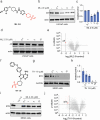DCAF16-Based Covalent Handle for the Rational Design of Monovalent Degraders
- PMID: 39071058
- PMCID: PMC11273451
- DOI: 10.1021/acscentsci.4c00286
DCAF16-Based Covalent Handle for the Rational Design of Monovalent Degraders
Abstract
Targeted protein degradation with monovalent molecular glue degraders is a powerful therapeutic modality for eliminating disease causing proteins. However, rational design of molecular glue degraders remains challenging. In this study, we sought to identify a transplantable and linker-less covalent handle that could be appended onto the exit vector of various protein-targeting ligands to induce the degradation of their respective targets. Using the BET family inhibitor JQ1 as a testbed, we synthesized and screened a series of covalent JQ1 analogs and identified a vinylsulfonyl piperazine handle that led to the potent and selective degradation of BRD4 in cells. Through chemoproteomic profiling, we identified DCAF16 as the E3 ligase responsible for BRD4 degradation-an E3 ligase substrate receptor that has been previously covalently targeted for molecular glue-based degradation of BRD4. Interestingly, we demonstrated that this covalent handle can be transplanted across a diverse array of protein-targeting ligands spanning many different protein classes to induce the degradation of CDK4, the androgen receptor, BTK, SMARCA2/4, and BCR-ABL/c-ABL. Our study reveals a DCAF16-based covalent degradative and linker-less chemical handle that can be attached to protein-targeting ligands to induce the degradation of several different classes of protein targets.
© 2024 The Authors. Published by American Chemical Society.
Conflict of interest statement
The authors declare the following competing financial interest(s): ACK and JWP are employees of Novartis BioMedical Research. This study was funded by Novartis BioMedical Research and the Novartis-Berkeley Translational Chemical Biology Institute. DKN is a co-founder, shareholder, and scientific advisory board member for Frontier Medicines and Vicinitas Therapeutics. DKN is a member of the board of directors for Vicinitas Therapeutics. DKN is also on the scientific advisory board of The Mark Foundation for Cancer Research, Photys Therapeutics, Apertor Pharmaceuticals, Oerth Bio, and Deciphera Pharmaceuticals. DKN is also an Investment Advisory Partner for a16z Bio+Health, an Advisory Board member for Droia Ventures, and an iPartner at The Column Group.
Figures






References
-
- Krönke J.; Udeshi N. D.; Narla A.; Grauman P.; Hurst S. N.; McConkey M.; Svinkina T.; Heckl D.; Comer E.; Li X.; Ciarlo C.; Hartman E.; Munshi N.; Schenone M.; Schreiber S. L.; Carr S. A.; Ebert B. L. Lenalidomide Causes Selective Degradation of IKZF1 and IKZF3 in Multiple Myeloma Cells. Science 2014, 343 (6168), 301–305. 10.1126/science.1244851. - DOI - PMC - PubMed
-
- Mayor-Ruiz C.; Bauer S.; Brand M.; Kozicka Z.; Siklos M.; Imrichova H.; Kaltheuner I. H.; Hahn E.; Seiler K.; Koren A.; Petzold G.; Fellner M.; Bock C.; Müller A. C.; Zuber J.; Geyer M.; Thomä N. H.; Kubicek S.; Winter G. E. Rational Discovery of Molecular Glue Degraders via Scalable Chemical Profiling. Nat. Chem. Biol. 2020, 16 (11), 1199–1207. 10.1038/s41589-020-0594-x. - DOI - PMC - PubMed
Grants and funding
LinkOut - more resources
Full Text Sources
Miscellaneous
